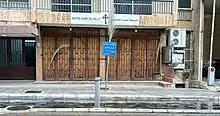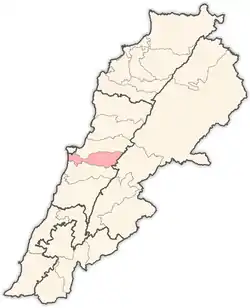Ain El Remmaneh
Ain El Remmaneh (Arabic: عين الرمانة, lit. spring of the pomegranate) is a Christian neighborhood, in the Baabda district[1] of Mount Lebanon, Lebanon,[2][3] a suburb of Beirut and part of Greater Beirut.[4]

History and war

In the 1950s, the populous town was known for gathering intellectuals and prominent personalities[5] like the poet Said Akl.
On April 13, 1975, it witnessed the serious church shooting and Bus Massacre security incidents, between the local Christian Kataeb party and the Arab Liberation Front militants and Palestinians, which sparked the 15-year-long civil war.[6]
During the Civil War, it became a war-torn[7][8][9] and an important stronghold of the Christian militias like the Lebanese Forces,[10] Kataeb, Ahrar,[11] Herras, etc., and witnessed violent battles, either with the Muslims across the Green Line with Chyah of the "West Beirut" on its border, the Syrian Forces, Palestianians and even inter-Christian conflicts,[12][13] and was known for its endurance, thus became known as the "fortress of resistance" (قلعة الصمود).[14]
In February 1990 General Aoun launched an unsuccessful campaign to dislodge Samir Geagea’s Lebanese Forces (LF) from East Beirut. Ain El Remmaneh became the scene of intense fighting and artillery exchanges which caused extensive damage and many casualties. The district fell to Auon’s soldiers on 15-16 February with LF fighters escaping by way of Syrian controlled West Beirut.[15]
Bus massacre

On April 13, 1975, a bus passing through Ain Al-Remmaneh, transporting Arab Liberation Front guerilla fighters and Palestinians returning from a festival, heading to their camp in Tel al-Zaatar, was gunned down by militiamen of the Kataeb party, killing all the 27 passengers except the driver, which marked the start of the Lebanese Civil War.[8][9][16] The incident happened just hours after 4 Christians were killed outside a nearby church[8] during a child's baptism in Ain El-Remmaneh in an assassination attempt of the Phalangist (Kataeb) leader Pierre Gemayel.[17][18][19]
Etymology
Ain El Remmaneh means "the water spring of the pomegranate tree", for the area was known to be covered with pomegranate and citrus trees before it was wiped out during the civil war.[14]
Overview

Ain El Remmaneh is managed by the municipality of Furn Al Chebbak, which also manages Tahwitet El Nahr (tahwita).[20] It is surrounded by Sin El Fil from the north, Chiyah from the South, Hazmieh from the East and Beirut from the West. Its strategic location has transformed it into an important urban area, with industrial and educational significance.[20]
See also
References
- Localiban. "Furn Ech Chebbak - Ain El Remmaneh - Tahouitat el Nahr - Localiban". www.localiban.org. Archived from the original on 2020-09-27. Retrieved 2021-02-22.
- "عين الرمانة (الشياح) | Libandata.org". www.libandata.org. Retrieved 2021-03-13.
- لوكاليبان. "فرن الشباك - عين الرمانة - تحويطة النهر - لوكاليبان". www.localiban.org (in Arabic). Archived from the original on 2020-10-26. Retrieved 2021-03-13.
- حرب لبنان: من عين الرمانة ..الى قوة الردع (in Arabic). Dār al-Ḥarakah al-Lubnānīyah. 1978.
- "عين الرمانة والشياح... تاريخ الدم و'الحبّ'". annahar.com. Retrieved 2021-03-14.
- Hirst, Beware of small states: Lebanon, battleground of the Middle East (2011), p. 99.
- "المعركة بين الحروب". عربي21 (in Arabic). 2021-02-18. Retrieved 2021-03-13.
- readApril 13, Marea DonnellyHistory writer3 min; 2015 - 12:00am (2015-04-12). "Deadly bus shooting echoed across slaughter of civil war". dailytelegraph. Retrieved 2021-03-13.
- Libnanews, Newsdesk. "Lebanon / Civil War: A Day in Hell, April 13, 1975". libnanews.com (in French). Retrieved 2021-03-13.
- حرب لبنان: من عين الرمانة ..الى قوة الردع (in Arabic). Dār al-Ḥarakah al-Lubnānīyah. 1978. p. 89.
- Khuwayrī, Anṭwān (1975). Ḥawādith Lubnān (in Arabic). Dār al-Abjadīyah. p. 301.
- Bashīr al-Jumayyil: al-Waʻd, al-qarār wa-al-wafāʼ, 3 (in Arabic). Muʼassasat Bashīr al-Jumayyil. 1984.
- جورج, سعادة، (1998). قصتي مع الطاىف: حقائق ووثائق، ملابسات ومعاناة، سوء تنفيذ وخيبة أمل (in Arabic). [s.n.]،. p. 310.
- "عين الرمانة والشياح... تاريخ الدم و'الحبّ'". annahar.com. Retrieved 2021-03-14.
- Middle East International No 370, 2nd March 1990, Publishers Lord Mayhew, Dennis Walters MP; Jim Muir pp.6,7,8
- Times, Juan de Onis Special to The New York (1975-04-14). "22 PALESTINIANS KILLED IN BEIRUT (Published 1975)". The New York Times. ISSN 0362-4331. Retrieved 2021-03-13.
- Lerner, K. Lee; Lerner, Brenda Wilmoth (2006). Terrorism: Essential Primary Sources. Thomson Gale. p. 61. ISBN 978-1-4144-0621-3.
- B. A., Politics and History. "Timeline of the Lebanese Civil War From 1975-1990". ThoughtCo. Retrieved 2021-03-13.
- Ramsperger, Kathryn Brown (2017-11-16). The Shores of Our Souls. TouchPoint Press via PublishDrive.
- "Furn El Chebbak, Ain El Remmaneh and Tahwitet El Nahr: cities of multiple facets". www.lebanesemunicipalagenda.com. Retrieved 2021-02-22.
